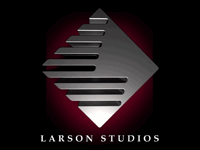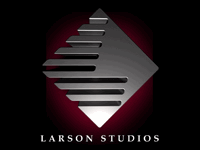Larson Studios: Award-Winning Post-Production In The Heart of Hollywood
Featuring the latest Blue Sky systems.
 Housed in two 10,000 square-foot landmark buildings in the heart of Hollywood, Larson Studios features two ADR/Foley stages, six edit suites, and six theater-style 5.1 or 7.1 surround mix stages all utilizing the latest Pro Tools HD Accel technology and Blue Sky monitoring systems. Larson employs nearly a dozen Sky System One systems in its two facilities—three 5.1 systems as primary mix speakers, four 2.1 systems as midfield monitors, and three 2.1 systems—to handle ADR, voiceovers, Foley, editorial and mixing functions.
Housed in two 10,000 square-foot landmark buildings in the heart of Hollywood, Larson Studios features two ADR/Foley stages, six edit suites, and six theater-style 5.1 or 7.1 surround mix stages all utilizing the latest Pro Tools HD Accel technology and Blue Sky monitoring systems. Larson employs nearly a dozen Sky System One systems in its two facilities—three 5.1 systems as primary mix speakers, four 2.1 systems as midfield monitors, and three 2.1 systems—to handle ADR, voiceovers, Foley, editorial and mixing functions.
Long-time Larson staffers include Chris Unthank, who recently became the Director of Transfer Operations, and Chief Engineer, David Dondorf.
As a graduate in the Master Recording Program at Arizona’s Conservatory of Recording Arts and Sciences in 2000, Unthank relocated to Burbank and was hired into an entry-level position at Interlock Audio Post. Interlock Audio Post was subsequently purchased by Rick Larson a few years later, and became Larson Studios. “I was fortunate enough to be given the opportunity to help design and launch the newly renovated stages,” Unthank says.
Coming from a different direction, Dondorf relocated from Chicago to Los Angeles with a background in live sound and jingles, working as a touring sound engineer for a variety of bands before signing on with the Frank Zappa “Broadway the Hard Way” tour in 1988 as Chief Tech. He was invited to become Chief Engineer at Zappa’s UMRK Studios, and did so for the next ten years. That led him to West Productions in Burbank as a mixer on shows ranging from the X Files and The Practice. The next step was the opportunity of a lifetime, as he was brought into Rick Larson’s new studios, where he and Unthank helped design and build Larson Studios from the ground up.
Larson Studios has been a Blue Sky house since its inception. “We have used them from day one,” Dondorf emphasizes. “Performance and cost were the first considerations. We looked at a lot of competing product, but we were, and continue to be, blown away by the quality of the sound and ease of use. They were also very strongly recommended by [veteran audio design guru], Chuck Pell, so there was also a bit of trust involved. The reasons we have stayed with Blue Sky have been the sound and the absolutely brilliant support they give us.”
“And the Blue Sky’s integrate perfectly into our setups,” adds Unthank. “We are using between two and three Pro Tools HD systems per stage that are summed digitally, the outputs of which feed a Martin Sound MultiMax monitor control, feeding the Sky System Ones.
By having duplicate Blue Sky systems throughout its facilities, Larson’s engineers have both transparency and consistency when shows are moved between stages. “This is the first facility I have ever worked, where the mixers can trust their mix from room to room,” says Dondorf. “The Blue Sky’s require less EQ, interact with the room less, and provide a mixer the confidence to move around without wasting time. Much of our mixing does involve other speakers but nothing leaves a stage without checking it out on our Blue Skys. The client acceptance has been phenomenal, we have set producers up with there own Blue Sky systems.” Additionally, they’re incorporating Blue Sky’s Bass Management system into the mix. “Blue Sky’s BMC provides a smooth controllable transition to low frequencies, while also handling the LFE,” Dondorf explains. “When voicing a room, I rely on the built-in features of the bass management to quickly dial in exactly what I’m looking for.”
These days Larson mixers are working almost solely in 5.1 surround. “When we first started,” Unthank recalls, “we were doing lots of stereo and LCRS mixing. I would say that about 80-90% of our shows are mixing in 5.1.”
“But,” says Dondorf. “We are starting to see more projects requiring 7.1 mixes, so we’re starting to work in that configuration as well.”
